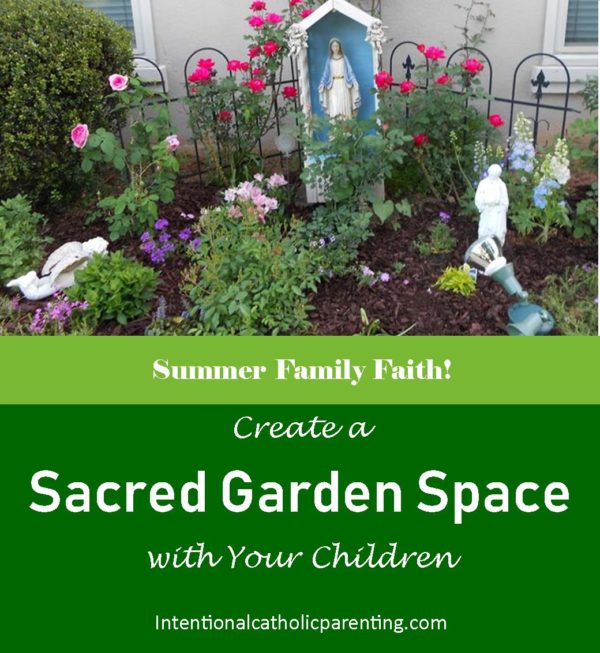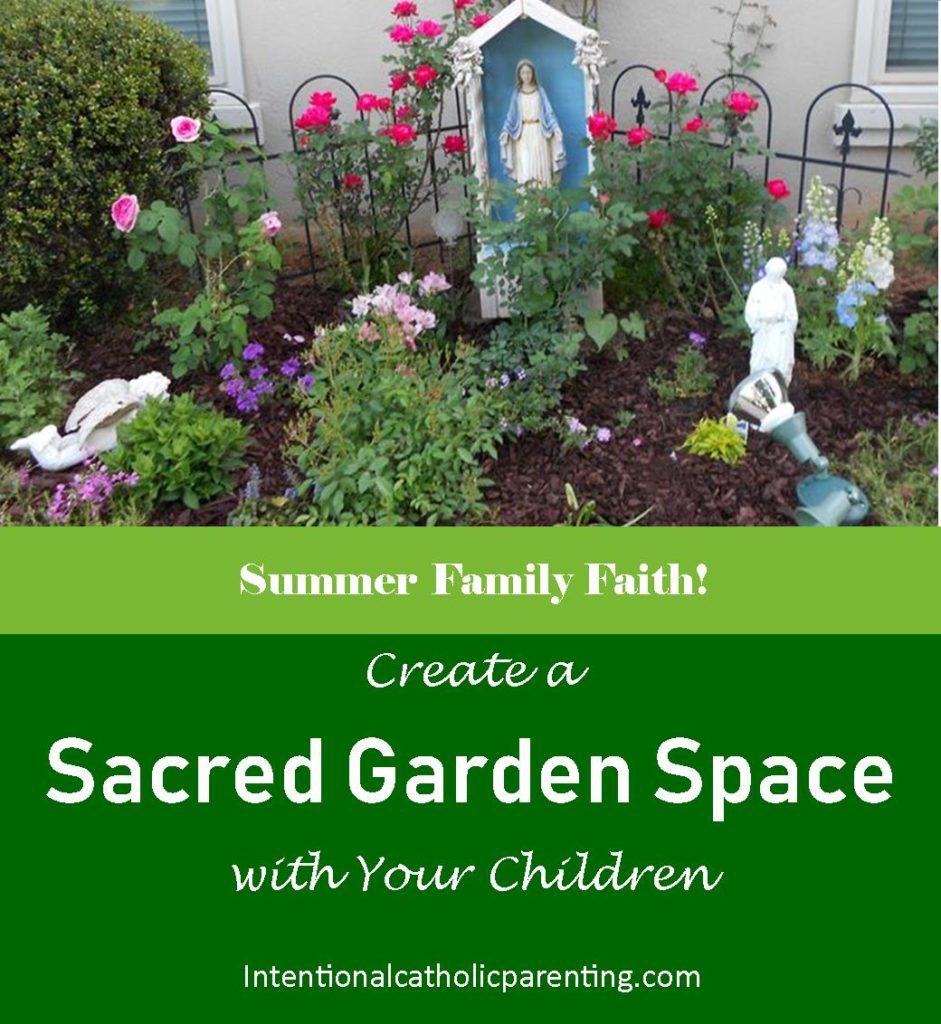“Gardens offer us a space where both plants and people can grow. We find all our senses are engaged in a garden, even if we are impaired in some way. By creating a sacred space, we allow our spirit to grow in such a way that our interior landscape can reveal hidden hope.” Margaret Rose Realy in A Garden of Invisible Prayer
A note from Kim: Here’s an update on my summer garden post!
I love working on projects with my kids over the summer. We often have more flexibility in our schedule during the day, so we can enjoy hours of working and playing together without interruption.
As these summer days wind down, we may have time for one more project. I have a special idea to share with you: create a sacred garden space with your children. This can be a small private retreat for prayer and contemplation, or your whole family can join here to pray an evening rosary. You don’t have to overhaul your entire backyard; just a small space will do.
Inspired by the work of Catholic writer and master gardener Margaret Rose Realy, I have been planning a few sacred spaces in our back garden with my children. With the drought in California, our garden has become stressed and needs refreshing. I have dreamed for years about making it my own anyway, as it was already landscaped when we moved into the house. Margaret has given me confidence that I can take it a step at a time to create something special with my family – something that reflects us and our faith life. I want our sacred space to be a welcoming outdoor sanctuary for my family and our guests, but I also want it to be kid friendly – and kid inspired.
If you’re intrigued, here are a few practical steps for creating a sacred garden with your children this summer:
1. Choose a focal point
After you’ve chosen a spot for your sacred garden, you can plan it out. Select a focal point that you can build around, such as a large religious statue or a cross. You don’t have to spend a fortune; you can find many affordable options on-line.This 3-foot tall Mary statue is $68 on Amazon:
This focal point should be something that matters to your family; you don’t have to replicate what you see in a book or in your neighbor’s yard. Let your children contribute to the decision making so they feel this is their garden, too.
2. Add hardscape
Hardscape is any kind of rocks, pavers, trellises, or art that you add to your space. You might add a trellis behind your focal point. Use stepping stones or rocks to draw attention to your focal point. Here are some more ideas:
- Use 7 stones to represent the 7 gifts of the Holy Spirit or the 7 joys of Mary (from the Franciscan crown).
- Have your children paint rocks representing some of the virtues or the sacraments.
- Hang personalized art created by your children on a small trellis or shepherd’s hook, or help your children create mosaic pavers like the ones pictured below. Books like Gardening with Kids (Catherine Woram) have ideas for crafts and art projects specifically for the garden.
3. Add seating
Add a bench or chair so your family or friends can sit while praying or reflecting. My daughter Lydia and I are currently repainting a wooden bench together which will work beautifully in our sacred space. You can also use old tree stumps as seats, or stretch a slab of wood across two stacks of cinder blocks. In a pinch, snag a few of those plastic Adirondack chairs that come in many different colors at home goods stores. They even sell small ones for children.
4. Add plants
You can put any kind of flowers or plants in your sacred garden, but many Catholics enjoy the symbolism in flowers connected to Mary’s life: roses, rosemary, marigold, etc. I think a herb garden would also be fitting, with some marigolds as a border.
In this wonderful article, Margaret shares how we can create a fruits of the Holy Spirit garden to recall Pentecost or the Transfiguration. There are 12 fruits of the Holy Spirit, but Margaret suggests choosing 3 to focus on in your garden. For example, blue flax is symbolic of kindness, the buttercup of generosity, and ornamental grasses of gentleness. These 3 would work beautifully together in a small garden area.
Don’t let perfectionism keep you from starting a sacred garden space. Your garden doesn’t need to be Instagram ready or perfectly manicured. Start small and be realistic, and view this project through the eyes of your children. Children seem to be natural gardeners: fearless, curious, and full of wonder.
Do you have any tips for starting a sacred garden or gardening with kids? Share your thoughts with us!
Resources
A Garden of Visible Prayer by Margaret Rose Realy
A Catholic Gardener’s Spiritual Almanac by Margaret Rose Realy
Mary’s Flowers: Gardens, Legends, and Meditations by Vincenzina Krymow
Roots, Shoots, Buckets, and Boots by Sharon Lovejoy





I love this article! My children love gardening. We grow many things and we have a Mary statue but I have never thought about incorporating more symbolic plants around her! Thanks for the new ideas!!
Hi Cally! Thank you for your comment. I love gardening with my kids, too!